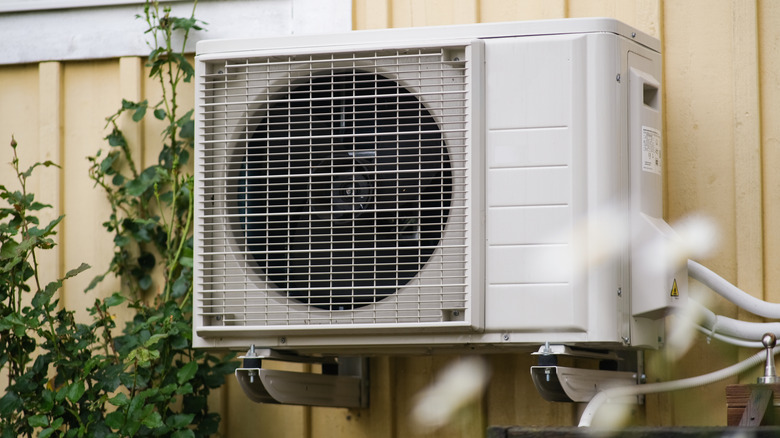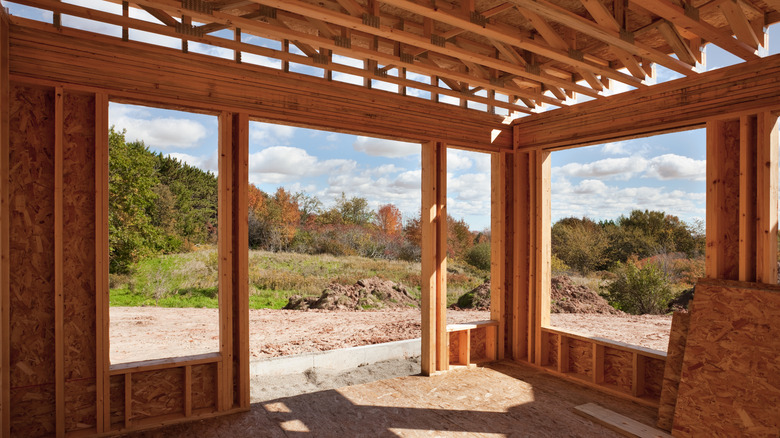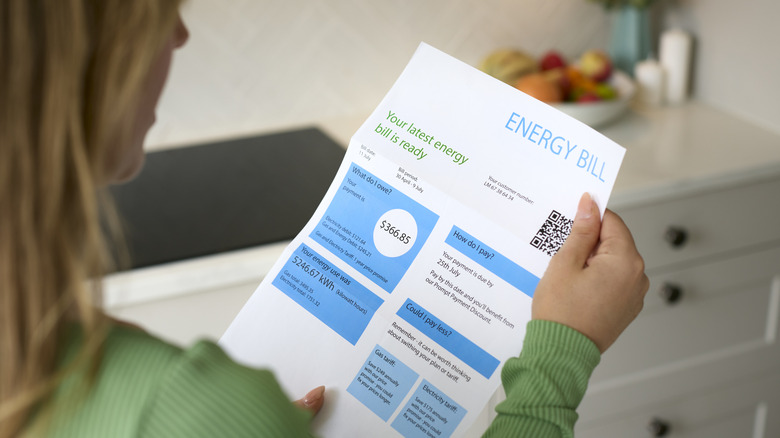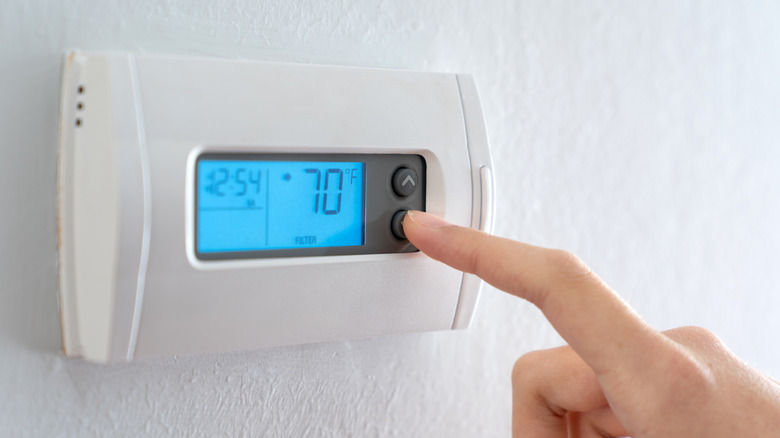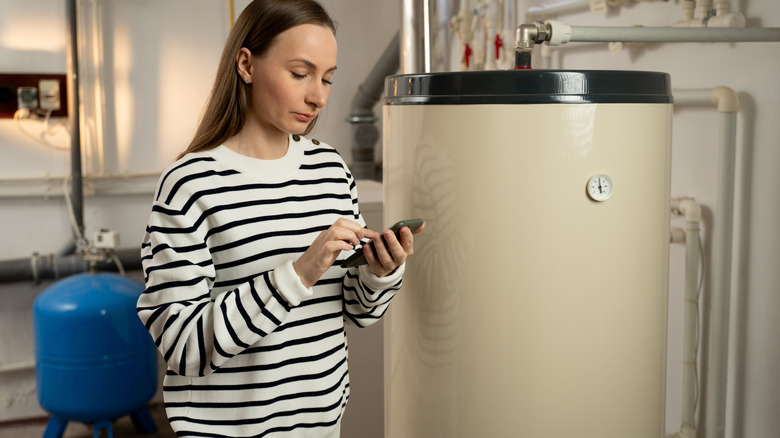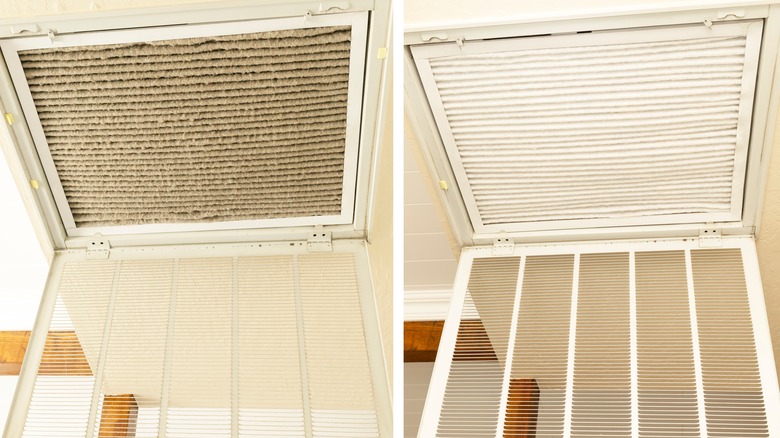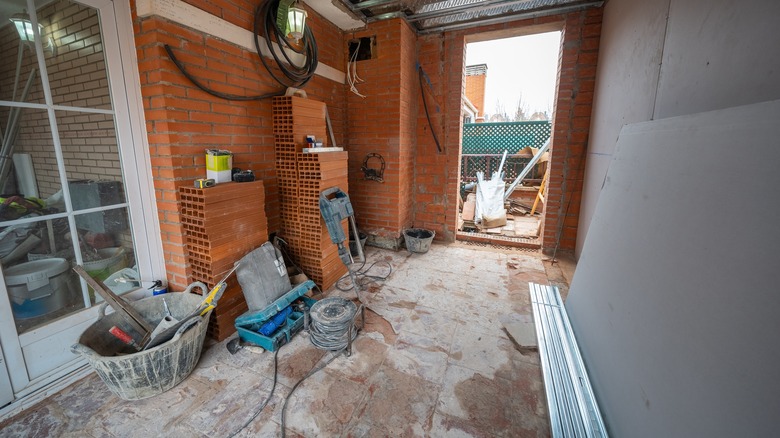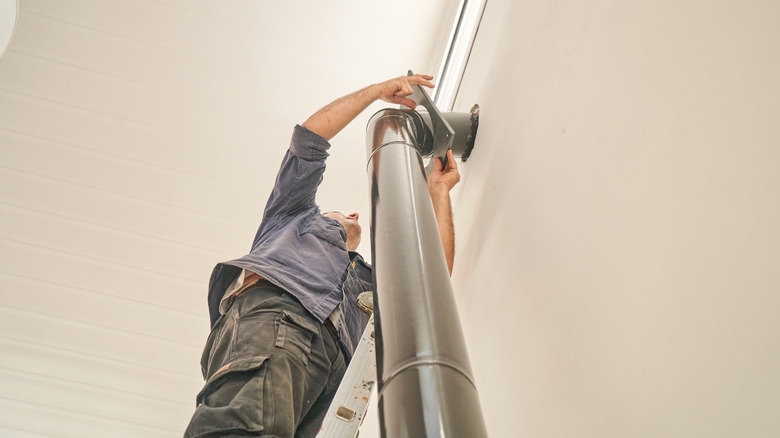9 Signs Your HVAC Might Be In Trouble, According To Mike Holmes
We may receive a commission on purchases made from links.
These are the major signs your HVAC might be in trouble, according to HGTV star Mike Holmes. The Canadian contractor is known for his straightforward, trustworthy home maintenance tips, like keeping your home cool in the summer by planting trees near your windows to keep the heat out. He has also run into many heating and cooling systems on the blitz through his decades on the job. Sometimes, the problems are easy to identify and not too costly to fix, like a visible leak in the system or strange smells wafting out of it. Other times, like when your energy bill suddenly skyrockets with no explanation, there could be something more serious afoot.
He is quick to point out the troubleshooting you can complete on your own, and what you will need to call a professional to take a look at. Something to always consider, however, is that Holmes recommends replacing your HVAC system entirely if fixing the problems costs 50% or more of the price of a new system. Much like when you total a car, there is a certain price point that, once reached, it's just not worth it to continue repairs. The cost to repair your HVAC system can vary. However, a brand new HVAC system, while expensive, can also save you money in the long run, as they tend to be significantly more energy efficient than older models.
Your home's new addition feels stuffy or stale
If the temperature in your addition feels different than the rest of the house, your HVAC system may not be keeping up. These systems are typically designed to serve the original square footage of the home. When new rooms are added, the existing HVAC often can't effectively serve the added space. "Often, airtight homes have ventilation systems that are insufficient or not appropriately designed to ensure the correct amount of fresh air is coming in," Holmes explained on Make It Right. "This causes the home to feel stuffy and stale."
That's exactly why Holmes planned ahead when building his own home addition. "When I built my sunroom, I made sure it was extremely airtight. However, I installed an ERV (energy recovery ventilator) to create an air exchange and manage moisture," he said on YouTube. "ERVs are designed to connect to the HVAC system in your home. They pull fresh, clean air into the building and remove stale or unclean air." In the instance of just one new room, Holmes' solution of an ERV is the best air system for your home. However, others recommend that if you add more than 200 square feet of space to your home, it's time to change your HVAC system. You will either need to replace the original unit with a larger, more powerful option to effectively keep up, or add a second one to take care of the new space.
Your energy bills start to go up
If you've lived in your home for a while, you likely have a good idea of what it costs to run your HVAC system in each season. Even with a rate increase, a sudden, rapid spike should be cause for concern. "Higher energy bills are among the first signs that your HVAC system may be failing," Holmes wrote for Make It Right. "It's your HVAC system telling you it's working overtime." The reason for this is that your system can wear itself out through the years. The older it gets, the less likely it'll be able to heat and cool your home effectively, even with regular servicing.
Holmes recommends consulting a professional to see what exact issue is causing the system to overwork. It could just be age, in which case he recommends updating the system to save on energy bills. It could also be something like damaged ductwork, which also typically requires professional assessment. That said, sometimes there are smaller issues that you can correct yourself to see if it lowers your bill. For example, there could be a blockage in your system, perhaps from a clogged filter. Check yours and replace it with a new one in the appropriate size, like a Filterbuy Air Filter, which comes in a pack of four. Regardless, these filters should be changed at least every 90 days to prevent a buildup.
You notice a lot of weird noises and smells
If you start hearing strange sounds coming from your HVAC system, it might be a major sign that it's in trouble. However, different signs can mean different issues, so Holmes recommends you understand the difference. "It could mean a failing blower motor or compressor if you hear banging or clanking," he shared on Make It Right. "A screeching or squealing sound could mean worn-out belts or motor bearings. Rattling, delayed ignition or hissing" — none of these mean anything good, he continued. Something to consider, however, is that these aren't just one-off sounds. To be a cause for concern, the sounds should be consistent, even after turning the system off, then on again. If they resume, it's time to call a technician.
Like disturbing noises, strange smells can also be a sign that something is amiss. If you turn on your HVAC and it smells like something is burning, it could mean there are overheating parts, or its wires are melting. This is very dangerous, and you should turn it off right away, as these are warning signs that precede an electrical fire. "Rotten egg smells could mean a gas leak, while musty odors could mean mould or mildew in your system," Holmes continued. A musty smell typically means your ducts just need to be cleaned out, but if you smell mercaptan, the substance added to gas to make it noticeable, evacuate your home immediately and call your gas company.
The temperature isn't staying consistent (or at the level you would like)
When you ask your HVAC system to reach a certain temperature, it should be able to reach it. That is, if you set it to 75 degrees Fahrenheit and hours later it's still at 82 degrees Fahrenheit, it's in trouble. "If you're constantly adjusting the thermostat and your HVAC system still isn't keeping up, that's a red flag," Holmes wrote for Make It Right. "A healthy system should respond quickly and keep your home at the right temperature without a struggle." If it's extremely hot or cold outside, it might take longer for things to even out, but the general rule is that a working HVAC can adjust the ambient temperature of a home by about 3 degrees Fahrenheit each hour. Anything outside of this is a cause for concern.
Holmes' solution for a system that isn't responding to input is a professional check. "A delayed or unresponsive system could indicate failure," he said. "If some rooms are too hot while others are too cold, it may be a sign of a struggling system, clogged ducts, or failing components." However, there are some troubleshooting options to try before calling in a pro. Check your air filters, just in case. You can also make sure your intake vents aren't accidentally blocked. Finally, consider that the problem isn't your HVAC system, but your insulation. It could be that the air is the right temperature, but it's just leaking out through single-pane windows or deteriorating weatherstrips.
Your basement temperature feels completely unregulated
Converted spaces like finished basements or garage renovations often come with unexpected HVAC issues. Unlike brand-new additions that may require separate HVAC solutions, these retrofitted rooms typically rely on the existing system — which can easily become unbalanced if not adjusted properly. "A finished basement increases the amount of space that the furnace needs to heat," Holmes explained on Facebook. "It takes at least one vent opening from the heating ducts and at least one cold air return." While it's often easiest to DIY parts of finishing a basement, like laying the flooring, Holmes insists temperature control is best left to the professionals from the outset.
In one real-world case, one of Holmes' clients had a 17-degree difference between their basement and the rest of the home. The issue wasn't with the furnace itself. It worked as intended, but almost half of the treated air leaked from the ducts before it could reach the basement! In this case, the issue here was sloppy installation of ductwork when finishing the basement, although not installing enough of it, or venting it in the incorrect spots, can also be issues when finishing a basement. If this problem occurs after your renovation is complete, whether right away or years later, leaks are typically to blame and should be corrected by a professional.
You haven't been maintaining your HVAC system
If you don't know when the last time your HVAC system was inspected, it's a bad sign. Ignoring routine maintenance can lead to bigger problems down the line because even the smallest of issues can quickly begin to snowball. If you haven't been changing the filters or had your system inspected in ages, chances are, it needs to be updated. If you can't remember the last time, then it's already been too long.
Holmes recommends an easy way to create good HVAC habits is to start by paying close attention to your filters. "At minimum, they should be changed every three months," he posted on Facebook. "But get in to the habit of checking them once a month and changing them as necessary." If you have lots of pets, or live somewhere with a particularly dusty or sandy climate, they can clog quicker, leading to system breakdown. Another healthy habit to keep is to schedule professional inspections for the system before you're likely to be uncomfortable without them. "Schedule a maintenance call for your furnace before winter sets in — because if it breaks in the middle of January, believe me, you're going to feel it," Holmes shared in another Facebook post. The same goes for your air conditioner, too. If you have it looked at in the springtime, you are likely to thank yourself in July when it's all smooth sailing.
You left it running during a renovation, and now there's dust everywhere
A useful tip to prolong the life of your HVAC system is to turn it off during major renovations. "When the dust and debris are flying, keeping the HVAC shut off can help prevent it from getting into the system," he posted on Instagram. This keeps the system from sucking up all the renovation dust and redistributing it around your house for months as it clears out of the vents. By turning it off, the clean-up is way easier. "Once the job is done, do a check on your filters, and change if necessary," he continued.
If you did leave the system running, it may have taken on more than just a little dust. This can be a cause for concern, as renovation debris can build up inside, making the system work harder than it should. To save your HVAC system from any further trouble, a post-project inspection and cleaning can help restore performance and prevent small issues from turning into costly repairs. If you're unsure where to start, reach out to a licensed HVAC technician and let them know your home recently underwent renovation and you suspect compromised ducts due to dust distribution. They'll know exactly what to look for.
Your room is always freezing or boiling
If one room in your house is always consistently a different temperature from the rest of your space, it could indicate an issue with your HVAC system. Typically, this is a sign of a leaking duct. Because ducts are out of sight, they are often out of mind, too. However, it can be an expensive problem if left unchecked. "Leaking ducts can cause you to lose up to 20% of your airflow — that's air you've paid to either heat or cool," Holmes wrote for Make It Right. "That really adds up." The reason this happens is that the HVAC ducts near that room might have a crack in them, or there could be a gap in a connection point. The treated air seeps out and doesn't make it into the room, hence the massive temperature difference from the rest of the house.
Holmes admits that homeowners might not need to call a professional to fix this issue, but it's a tricky DIY job and should only be undertaken if you have plenty of experience. "It will take a lot of time, and accessing your ductwork may involve busting into your drywall, so I wouldn't recommend it," he shared. "But with enough mastic sealant, time, and patience, you could solve it." For those with the know-how, a duct sealant putty, like Red Devil F-Seal Duct Seal, can solve the issue if applied properly. However, for most, it's easier to call a technician.
You notice the ductwork is only on one side of your house
Sometimes, it seems like the temperature control problems aren't just in one room — they affect an entire side of the house. In these cases, there isn't likely anything wrong with the ducts themselves, but rather, they have been placed poorly. Your HVAC is in trouble in this case, because it will never function properly if not addressed. "I've seen too many homes with 80% of the ductwork on just one side of the house. And then you wonder why some rooms are always cold. The problem isn't airflow. It's the ductwork," Holmes told the Times Colonist.
There are two solutions to this problem, depending on your budget. The first is to install a booster fan, like the AC Infinity Register Booster Fan. "The idea is that a booster fan can push air to that room," Holmes continued. They are very loud, but people choose them because they are cheap. Although most modern fans are marketed as quieter, your results do depend on the model you choose. If you don't notice an improvement after installing booster fans, the second solution is unfortunately to replace the ductwork, rerouting it so it is more evenly distributed throughout your property. This way, it won't have to work as hard to give you better temperature results, and save you money on energy bills, too. Although the initial upfront costs can be quite a lot, with the contractor citing $10,000 as the typical project cost.
